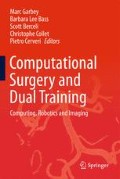Abstract
The existence of residual motion with passive cardiac stabilizers hinders the development of minimally invasive beating heart procedures such as Coronary Artery Bypass Grafting (CABG). This issue can be overcome thanks to active stabilization. It consists in actuating the stabilizer in order to compensate in real time for residual heart motion. This approach has been investigated with the design of two different devices: the Cardiolock and GyroLock systems. Both are presented here and assessed based on experimental results obtained in vivo, proving the efficiency of the active stabilization approach for the heart motion compensation.
Access this chapter
Tax calculation will be finalised at checkout
Purchases are for personal use only
References
Bachta W, Renaud P, Laroche E, Forgione A, Gangloff J (2008) Cardiolock: an active cardiac stabilizer, first in vivo experiments using a new robotized device. Comput Aided Surg 13(5):243–254 doi:10.3109/10929080802413129
Bachta W, Renaud P, Laroche E, Forgione A, Gangloff J (2011) Active stabilization for robotized beating heart surgery. IEEE Trans Robot 27(4):757–768
Bachta W, Renaud P, Laroche E, Gangloff J (2011) The Cardiolock project: Design of an active stabilizer for cardiac surgery. J Mech Des 133(7):1–10
Bodson M (2001) Performance of an adaptive algorithm for sinusoidal disturbance rejection in high noise. Automatica 37(7):1133–1140
Gagne J, Laroche E, Piccin O, Gangloff J (2010) Active heart stabilization using noise cancelling techniques with gyroscopic actuation. In: Proceedings of the 2010 3rd IEEE RAS & EMBS international conference on biomedical robotics and biomechatronics, BioRob 2010, pp 802–807, Tokyo, Japan, September 2010
Gagne J, Piccin O, Laroche E, Gangloff J (2010) A heart stabilization device exploiting gyroscopic actuation: design and control. In: Proceedings of the ASME 2010 international design engineering technical conference and computer and information in engineering conference, IDETC/CIE 2010, Montreal, Quebec, Canada, 15–18 August 2010
Gagne J, Piccin O, Laroche E, Diana M, Gangloff J (2011) GyroLock—first in vivo experiments of active heart stabilization using control moment gyro (CMG). In: IEEE international conference on robotics and automation ICRA 2011, pp 404–410, Shanghai, China, 9–13 May 2011
Huffmyer J, Raphael J (2011) The current status of off-pump coronary bypass surgery. Curr Opin Anaesthesiol 24(1):64–69
Lemma M, Mangini A, Redaelli A, Acocella F (2005) Do cardiac stabilizers really stabilize? Experimental quantitative analysis of mechanical stabilization. Interact Cardiovasc Thorac Surg 4(3):222–226
Loisance DY, Nakashima K, Kirsch M (2005) Computer-assisted coronary surgery: lessons from an initial experience. Interact Cardiovasc Thorac Surg 4(5):398–401
Mack MJ (2006) Minimally invasive cardiac surgery. Surg Endosc 20:488–492
Nakamura Y, Kishi K, Kawakami H (2011) Heartbeat synchronization for robotic cardiac surgery. IEEE international conference on robotics and automation, proceedings 2001 ICRA, vol 2, pp 2014–2019, Seoul, Korea, 21–26 May 2001
Patronik NA, Zenati MA, Riviere CN (2005) Preliminary evaluation of a mobile robotic device for navigation and intervention on the beating heart. Comput Aided Surg 10(4):225–232
Trejos AL, Salcudean SE, Sassani F, Lichtenstein S (1999) On the feasibility of a moving support for surgery on the beating heart. Medical image computing and computer-assisted intervention – MICCAI’99. Springer, Berlin
Acknowledgments
The authors are grateful to the Research Institute against Digestive Cancer (IRCAD) for providing the conditions and equipment allowing to perform in vivo assessments. Thanks to Antonello Forgione and Michele Diana who contributed to those experiments as surgeons.
Author information
Authors and Affiliations
Corresponding author
Editor information
Editors and Affiliations
Rights and permissions
Copyright information
© 2014 Springer New York
About this chapter
Cite this chapter
Gagne, J., Bachta, W., Renaud, P., Piccin, O., Laroche, É., Gangloff, J. (2014). Beating Heart Surgery: Comparison of Two Active Compensation Solutions for Minimally Invasive Coronary Artery Bypass Grafting. In: Garbey, M., Bass, B., Berceli, S., Collet, C., Cerveri, P. (eds) Computational Surgery and Dual Training. Springer, New York, NY. https://doi.org/10.1007/978-1-4614-8648-0_13
Download citation
DOI: https://doi.org/10.1007/978-1-4614-8648-0_13
Published:
Publisher Name: Springer, New York, NY
Print ISBN: 978-1-4614-8647-3
Online ISBN: 978-1-4614-8648-0
eBook Packages: EngineeringEngineering (R0)

